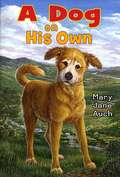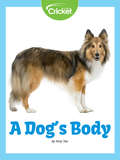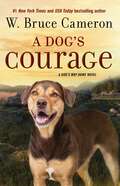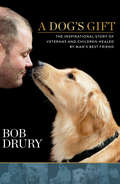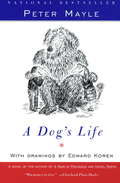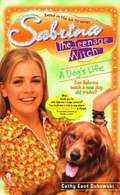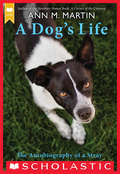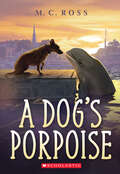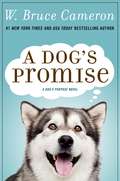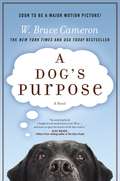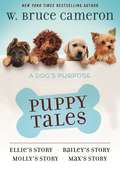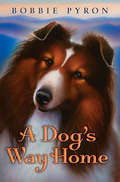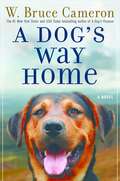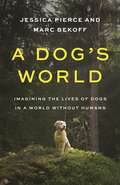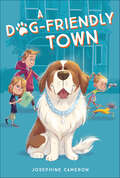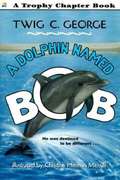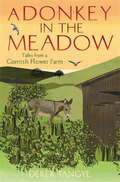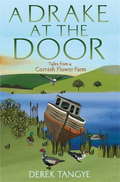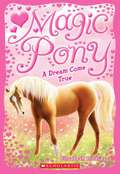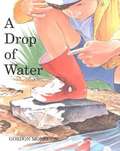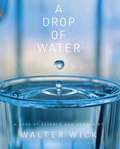- Table View
- List View
A Dog on His Own
by Mary Jane AuchA funny and moving middle-grade novel for dog lovers by popular author Mary Jane Auch. Other dogs are K-9s. But K-10 is a cut above other dogs, and his mother gave him the name to prove it when he was a puppy. Now K-10 is grown up and all on his own, because K-10 doesn't need friends--canine or human. He spends his time running away from owners and doing time in dog shelters, and that's just fine with him. But after K-10 escapes from a shelter with some other dogs, everything changes. These new dogs aren't so easy to forget, and all they can bark about is finding old and new owners. Will K-10 go back to being a loner, or can this not-so-old dog learn a new trick--friendship?
A Dog to Trust: The Saga of a Seeing-Eye Dog
by Joseph E. ChipperfieldTells the story of Arno, an Alsatian dog also known as a German Shepherd Dog, who was trained as the eyes of Ralph, a painter who loses his sight, and in a twist of fate, Arno becomes blind and Ralph becomes his eyes.
A Dog's Best Friend: An Activity Book for Kids and Their Dogs
by John Caruso Lisa RosenthalOwning a pet can teach a child responsibility, patience, confidence, and the satisfaction of a job well done--and best of all, it's fun! Over 60 inventive activities and crafts such as Can Do Canine Show and Dog Day Story teach kids about taking care of their pooch pal while promoting a long-lasting relationship. Games such as musical chairs, burying bones together, and throwing a frisbee and flyball; fun things to make such as a rag rug, a pooch pillow, and a puppy bed; and yummy treats to cook such as crunchy dog biscuits and a dog food cake get kids involved with taking care of their dog's needs while teaching healthy care-giving techniques and fostering a deep friendship. In addition, A Dog's Best Friend includes information about dog obedience training; a reading list of children's animal books; listings of Web sites, pet-care resources, and animal organizations and events; and amusing trivia for dog lovers.
A Dog's Body
by Amy TaoDogs are amazing creatures with amazing bodies! Discover how fur protects their delicate skin, and which body parts gives them balance. Did you know dogs can wiggle their ears in many directions? Learn more facts about dogs and how their unique anatomy is different from other animals.
A Dog's Courage: A Dog's Way Home Novel (A Dog's Way Home Novel #2)
by W. Bruce Cameron#1 New York Times bestselling author W. Bruce Cameron once again captures the bravery and determination of a very good dog in the gripping sequel to A Dog’s Way Home, the acclaimed novel that inspired the hit movie! Bella was once a lost dog, but now she lives happily with her people, Lucas and Olivia, only occasionally recalling the hardships in her past. Then a weekend camping trip turns into a harrowing struggle for survival when the Rocky Mountains are engulfed by the biggest wildfire in American history. The raging inferno separates Bella from her people and she is lost once more.Alone in the wilderness, Bella unexpectedly finds herself responsible for the safety of two defenseless mountain lion cubs. Now she’s torn between two equally urgent goals. More than anything, she wants to find her way home to Lucas and Olivia, but not if it means abandoning her new family to danger. And danger abounds, from predators hunting them to the flames threatening at every turn.Can Bella ever get back to where she truly belongs?A Dog’s Courage is more than a fast-paced adventure, more than a devoted dog’s struggle to survive, it’s a story asking that we believe in our dogs as much as they believe in us.At the Publisher's request, this title is being sold without Digital Rights Management Software (DRM) applied.
A Dog's Gift: The Inspirational Story of Veterans and Children Healed by Man's Best Friend
by Bob DruryA decade ago, former military counterintelligence officer Terry Henry joined his precocious young daughter, Kyria, on a trip to a nursing home in order to allow its residents to play with their family dog, a golden retriever named riley. Terry was astounded by the transformations that unfolded before his eyes. Soon after, Terry and Kyria started their service dog organization, paws4people, with the goal of pairing dogs with human beings in need of healing, including traumatized and wounded war veterans and children living with physical, emotional, and intellectual disabilities.In A Dog's Gift, award-winning journalist and author Bob Drury movingly captures the story of a year in the life of paws4people and the broken bodies and souls the organization mends. The book follows the journey of pups bred by the organization from their loving, if rigorous, early training to an emotional event that terry and Kyria have christened "the bump," where each individual service dog chooses its new owner through an almost mystical connection that ignites the healing process. incorporating vivid storytelling, insights into canine wisdom, history, science, and moving tales of personal transformation, A Dog's Gift is a story of miracles bound to be embraced by not only the 60 million Americans who own dogs, but by anyone with a full heart and a loving soul.
A Dog's Life (El\balancí Ser. #Vol. 278)
by Peter MayleThe bestsellling author of A Year in Provence and Hotel Pastis now surveys his territory from a differnt vantage point: the all-fours perspective of his dog, Boy--"a dog whose personality is made up of equal parts Boswell and Dr. Johnson, Mencken and A. A. Milne" (Chicago Sun-Times). Enhanced by 59 splendidly whimsical drawings by Edward Koren.
A Dog's Life (Sabrina the Teenage Witch #9)
by Cathy East DubowskiWhen Harvey stops by Sabrina's house with Macdougal, the dog he's pet-sitting, he finds Sabrina elbow-deep in brownie batter. She's trying to bake like anormal teenager--without using her powers. But with some of her ingredients missing and her electric mixer on the blink, Sabrina decides to conjure up a little magical help. Suddenly, Sabrina's mixing spell goes horribly haywire, bouncing into the dining room and zapping Harvey and Macdougal. Now Harvey's in canine chaos and his voice is coming out of the golden retriever's drooling jaws! With the Quizmaster on her case and her best friend chasing cats, Sabrina's in the doghouse--unless she can find the trick that will get rid of Harvey's dog days for good!
A Dog's Life: The Autobiography Of A Stray
by Ann M. MartinNewbery Honor author Ann Martin's "heartwrenching and heartwarming" (Kirkus) dog story, now in paperback, with After Words bonus material. Squirrel and her brother Bone begin their lives in a toolshed behind someone's summer house. Their mother nurtures them and teaches them the many skills they will need to survive as stray dogs. But when their mother is taken from them suddenly and too soon, the puppies are forced to make their own way in the world, facing humans both gentle and brutal, busy highways, other animals, and the changing seasons. When Bone and Squirrel become separated, Squirrel must fend for herself, and in the process makes two friends who in very different ways define her fate.
A Dog's Porpoise
by M. C. RossA rambunctious mutt and a curious porpoise become best pals in this adorably charming story about friendship and family.When a bad storm throws Bangor, a harbor porpoise, off course, he finds himself all alone in the harbor of Ogunquit, Maine. And he's not the only one who's lost in these wayward waters: Lars, a rowdy pup, is knocked overboard a nearby boat. With the help of a girl named Natalie, Bangor rescues Lars, and they become fast friends. But not everyone in the small town approves of this unlikely friendship. Some find Lars a nuisance to the community, and it isn't safe for Bangor to remain in the harbor. It's up to Natalie to convince the town to locate Bangor's pod and return him safely home -- even if it means saying goodbye to her new friend. Full of humor and heart, A Dog's Porpoise asks readers to consider what it means to be a good friend, especially during tough times.
A Dog's Promise: A Novel (A Dog's Purpose #3)
by W. Bruce CameronA Dog's Promise continues the story of Bailey, the good dog whose journey started in A Dog's Purpose and continued in A Dog's Journey (both major motion pictures). This time, Bailey is joined by Lacey, another very special dog, who helps Bailey fulfill his promise over the course of several lives.This charming, wise canine soul brings joy, laughter, and comfort as he unites a family fractured by life's inevitable obstacles. The love and loyalty of these two memorable dogs shows us the incredible power of hope, truth, and unending devotion in this moving novel by award-winning author W. Bruce Cameron.At the Publisher's request, this title is being sold without Digital Rights Management Software (DRM) applied.
A Dog's Purpose
by W. Bruce Cameron<P>Heartwarming, insightful, and often laugh-out-loud funny, A Dog's Purpose is not only the emotional and hilarious story of a dog's many lives, but also a dog's-eye commentary on human relationships and the unbreakable bonds between man and man's best friend. <P>This moving and beautifully crafted story teaches us that love never dies, that our true friends are always with us, and that every creature on earth is born with a purpose. <P><b>A New York Times Bestseller</b>
A Dog's Purpose Puppy Tales Collection: Ellie's Story, Bailey's Story, Molly's Story, Max's Story (A Dog's Purpose Puppy Tales)
by W. Bruce CameronNew York Times bestselling author W. Bruce Cameron presents heartwarming novels for young readers adapted from his beloved A Dog’s Purpose novels. Adorable black-and-white illustrations by Richard Cowdrey bring the puppies and their worlds to life for young animal lovers, while reading and activity guides at the end of each book encourage family and classroom discussions.A Dog's Purpose Puppy Tales Collection discounted ebundle includes: Ellie’s Story, Bailey’s Story, Molly’s Story, Max’s StoryA Dog's Purpose Series #1: A Dog’s Purpose #2: A Dog’s Journey A Dog's Purpose Puppy Tales Ellie's Story Bailey’s Story Molly's Story Max's Story Toby's StoryA Dog’s Way Home Tale Shelby’s StoryOther Books A Dog’s Way Home The Dog Master The Dogs of Christmas Emory’s GiftAt the Publisher's request, this title is being sold without Digital Rights Management Software (DRM) applied.
A Dog's Way Home
by Bobbie PyronDaddy says, "Most folks got a north star in their life-something that gives their life extra meaning. Mine is music." Without even thinking, I say, "Mine is Tam." Abby knows that Tam, her Shetland sheepdog, is her north star, and she's pretty certain she's his, too. But when an accident separates Abby and Tam, it feels as though all the stars have fallen out of the sky and nothing will ever be right again. As the days between them turn to weeks, then months, dangers and changes fill up Abby's and Tam's lives. Will they ever find their way home to each other? Set in the Blue Ridge Mountains, A Dog's Way Home is an unforgettable tale of the many miles, months, and mountains that divide two loyal friends-but that can't possibly keep them apart.
A Dog's Way Home
by W. Bruce CameronSOON TO BE A MAJOR MOTION PICTURE! From W. Bruce Cameron, the author of the #1 New York Times and USA Today bestselling novel A Dog's Purpose <p><p> Lucas Ray is shocked when an adorable puppy jumps out of an abandoned building and into his arms. Though the apartment he shares with his mother, a disabled veteran, doesn't allow dogs, Lucas can't resist taking Bella home. Bella is inexplicably drawn to Lucas, even if she doesn't understand the necessity of games like No Barks. As it becomes more difficult to hide her from the neighbors, Lucas begins to sneak Bella into the VA where he works. There, Bella brings joy and comfort where it is needed most. <P>After Bella is picked up by Animal Control because pit bulls are banned in Denver, Lucas has no choice but to send her to a foster home until he can figure out what to do. But Bella, distraught at the separation, doesn't plan to wait. <P>With four hundred miles of dangerous Colorado wilderness between her and her person, Bella sets off on a seemingly impossible and completely unforgettable adventure home. A classic story of unwavering loyalty and incredible devotion, A Dog's Way Home is a beautifully told, charming tale that explores the unbreakable bond between us and our pets. <P>This fantastic and exhilarating journey of the heart is in the same tradition as the beloved bestseller, A Dog's Purpose. <P><b>A New York Times Bestseller</b>
A Dog's World: Imagining the Lives of Dogs in a World without Humans
by Marc Bekoff Jessica PierceFrom two of the world’s leading authorities on dogs, an imaginative journey into a future of dogs without peopleWhat would happen to dogs if humans simply disappeared? Would dogs be able to survive on their own without us? A Dog’s World imagines a posthuman future for dogs, revealing how dogs would survive—and possibly even thrive—and explaining how this new and revolutionary perspective can guide how we interact with dogs now.Drawing on biology, ecology, and the latest findings on the lives and behavior of dogs and their wild relatives, Jessica Pierce and Marc Bekoff—two of today’s most innovative thinkers about dogs—explore who dogs might become without direct human intervention into breeding, arranged playdates at the dog park, regular feedings, and veterinary care. Pierce and Bekoff show how dogs are quick learners who are highly adaptable and opportunistic, and they offer compelling evidence that dogs already do survive on their own—and could do so in a world without us.Challenging the notion that dogs would be helpless without their human counterparts, A Dog’s World enables us to understand these independent and remarkably intelligent animals on their own terms.
A Dog-Friendly Town
by Josephine CameronJosephine Cameron's A Dog-Friendly Town is a delightful middle-grade cozy caper sure to excite dog-lovers and gentle mystery readers alike!Twelve-year-old Epic McDade isn't ready for middle school. He'd rather help out at his family's dog-friendly bed n' breakfast all summer, or return to his alternative elementary school in the fall, where learning feels safe. But change comes in all shapes and fur colors. When Carmelito, California is named America's #1 Dog-Friendly Town, all the top dogs and their owners pour into Epic's sleepy seaside neighborhood for a week of celebration.The McDades are in dog heaven with all the new business until a famous dog's jewel-encrusted collar goes missing. Every guest is a suspect, and Epic will have to embrace new friends and new ideas to sniff out the culprit before the week is through.
A Dolphin Named Bob
by Twig C. GeorgeWhen Bob the dolphin was born, he was small and sickly, with an unusual comet-shaped mark on his drooping dorsal fin. No one at the aquarium expected him to survive. But like his mother, Aster, Bob was ornery, and he stubbornly struggled to overcome his health problems. And soon, he loved to leap high into the air and perform tricks. Then one day, Bob taught himself a new trick-and jumped into more trouble than any other dolphin in the history of the aquarium. With a dolphin like Bob around, you never know what will happen!
A Donkey in the Meadow: Tales from a Cornish Flower Farm (Minack Chronicles #6)
by Derek TangyeThe fourth title in the Minack Chronicles tells the story of how Derek and Jeannie acquired two donkeys, Penny and Fred. From the first steps and learning all about donkey foibles, through to picnics in the meadows, this is a further charming instalment in the tales of the Tangye's life at Minack.
A Donkey's Tale
by Stefano Gorla Angela MarchettiIn this awe-inspiring tale, the life of Jesus is imaginatively retold by an improbable witness: a donkey! Sensitively expressed and colorfully illustrated, A Donkey's Tale encourages children ages 6-8 to also be witnesses to the faith.
A Door for Furball (Fountas & Pinnell Classroom, Guided Reading)
by Mike Phillips Shannon PasseNIMAC-sourced textbook
A Drake at the Door: Tales from a Cornish Flower Farm (Minack Chronicles #8)
by Derek TangyeThe third title in the Minack Chronicles, which tell the story of how Derek and his wife Jeannie left behind their London home to establish a flower farm on the coast of Cornwall. This book takes a closer look at some of the animals who shared the Tangye's home and surroundings, especially Boris, the Muscovy duck.
A Dream Come True (Magic Pony)
by Elizabeth LindsayHorse-loving Annie has always wanted a pony. When she buys a pony poster from a magic shop, her dream unexpectedly comes true. The poster is magic and the pony comes to life! Ned, the pony is a lot of fun, but keeping him secret is a lot of work. When Annie's parents keep hearing mysterious noises and finding big messes, she has to figure out a way to save her best friend from discovery.
A Drop of Water
by Gordon MorrisonA child crouches beside a meadow brook, and a drop of water collects and falls from the child’s fingertip to continue on its journey. Where does that journey begin? High in the sky, rain clouds are parting. Water trickles and flows down the mountain, collecting in an upland bog, seeping through a beaver’s dam, rushing over rocks, passing many plants and animals along its winding way-each dependent on water and the different environments it shapes to live. Author and illustrator Gordon Morrison has captured a single moment in time, revealing the course and influence of water, and inviting readers to pause and consider the world around them in this beautiful and lyrical appreciation of nature and the resource that makes it all possible-a drop of water.
A Drop of Water
by Walter Wick<p>The most spectacular photographs ever created on the subject of water appear in this unique science book by Walter Wick. The camera stops the action and magnifies it so that all the amazing states of water can be observed - water as ice, rainbow, stream, frost, dew. Readers can examine a drop of water as it falls from a faucet, see a drop of water as it splashes on a hard surface, count the points of an actual snowflake, and contemplate how drops of water form clouds. <p>[This text is listed as an example that meets Common Core Standards in English language arts in grades 2-3 at http://www.corestandards.org.]
